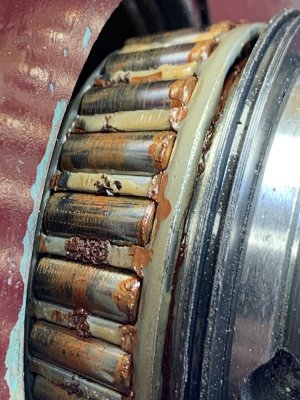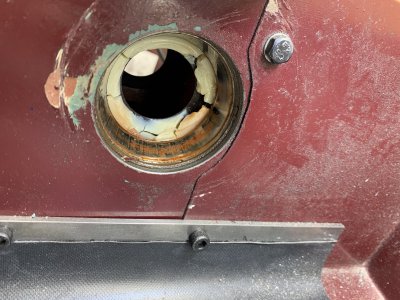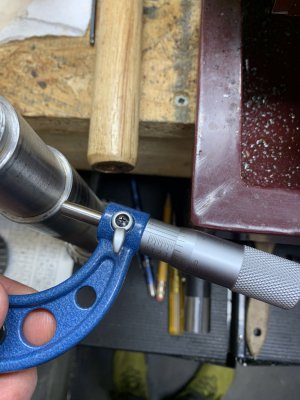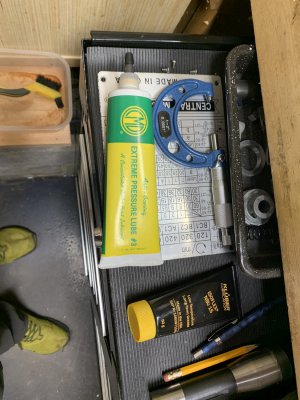- Joined
- May 3, 2020
- Messages
- 363
I have a used 9x20. The original owner had installed tapered roller bearings and done a few other improvemements, so I assumed all was well. But this is the condition of the spindle bearings:


So I cleaned them up and re-installed. If I had new bearings, I would have used them but I have a job coming up so I needed it re-assembled for Monday. The shaft for the rear bearing was 34.991 mm, which is a 0.009 mm interference fit for the 32007X bearing. That's 4 tenths. Such a relief. I had read about the procedure and the importance of a proper fit for setting pre-load but had no way to make corrections, if the fit had been too tight.
Seems like spindle grease is a constant debate over the years. I was able to get some Kluuber Isoflex NBU 15, so I used that. The previous owner may have used the same grease. There was a lot of it in the dust shield inside the casting. After cleaning thoroughly, I put on gloves, squeezed out a 3/4" nurdle of grease onto the rollers and messaged it in, making sure all surfaces where whetted. The I applied CMD to the ID of the rear bearing and pressed everything together. Ran for 20 min at 1000 RPM with the mildest warming. Much quieter! If I apply about 50 lb force to a bar in the chuck (6" away from front bearing) I get about 0.001 of deflection but it bounces back to 0.000. Same in both directions, with no obvious dead zone. I'd prefer to have it as stiff as possible, so I may end up increasing the pre-load after a bit more testing.




So I cleaned them up and re-installed. If I had new bearings, I would have used them but I have a job coming up so I needed it re-assembled for Monday. The shaft for the rear bearing was 34.991 mm, which is a 0.009 mm interference fit for the 32007X bearing. That's 4 tenths. Such a relief. I had read about the procedure and the importance of a proper fit for setting pre-load but had no way to make corrections, if the fit had been too tight.
Seems like spindle grease is a constant debate over the years. I was able to get some Kluuber Isoflex NBU 15, so I used that. The previous owner may have used the same grease. There was a lot of it in the dust shield inside the casting. After cleaning thoroughly, I put on gloves, squeezed out a 3/4" nurdle of grease onto the rollers and messaged it in, making sure all surfaces where whetted. The I applied CMD to the ID of the rear bearing and pressed everything together. Ran for 20 min at 1000 RPM with the mildest warming. Much quieter! If I apply about 50 lb force to a bar in the chuck (6" away from front bearing) I get about 0.001 of deflection but it bounces back to 0.000. Same in both directions, with no obvious dead zone. I'd prefer to have it as stiff as possible, so I may end up increasing the pre-load after a bit more testing.


